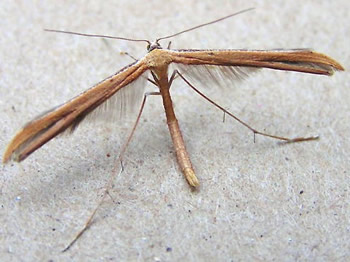|
__ |
|
Moths belong to the same order of insects as butterflies: Lepidoptera. The word lepidoptera comes from the Ancient Greek words of lepido, meaning scale and ptera for wings. |
|
There are over 160,000 species of moths around the world compared to only about 20,000 species of butterflies. North America is home to some 12,000 different species of moths. |
| |
|
|
|
|
|
Moths and butterflies all have six legs, four wings, two compound eyes and a a proboscis which is special organ used for sucking and feeding. |
|
When moths land and settle, they generally hold their wings open or wrap them around their bodies whereas butterflies prefer to close their wings |
| |
|
|
|
|
|
Moths have feathery or straight antennae; butterflies are have the knobs on the end of their antennae. |
|
While many moths are drab, lots are colourful like the Cinnabar Moth which was introduced to North America. |
| |
|
|
|
|
|
Moths in the family Noctuidae are called Owlet Moths and are generally nocturnal, like owls. |
|
Another family of moths is Arctiidae, the Tiger Moths which, like tigers, have bright colours or striking patterns. |
| |
|
|
|
|
|
Moths in the family Geometridae are called Geometrid Moths and have patterns and designs to help them blend into the background. |
|
The caterpillars of Geometrid moths are known as inchworms or loopers because of the way they move. Geometrid means earth-measurer in Greek. |
| | |
|
|
|
|
|
Another moth family is Lymantriidae: the Tussock Moths. Adults don't feed and some female Tussock Moths don't even fly. They lay their eggs on their own cocoon and stay close by. |
|
Plume Moths belong to the Pterophoriade family of moths. They have modified wings which allows them to hide from predators as they can roll up their wings and resemble a piece of grass. |
| |
|
|
|
|
|
Moths in the Tortricidae family are called Tortrix or Tortricoid Moths. Many, like the Obliquebanded Leafroller Moth,
Choristoneura rosaceana,
lay their eggs on the surface of leaves. |
|
Some moths like the One-eyed Sphinx Moth, Smerinthus cerisy, have patterns which reassemble eye spots to distract predators from their body to the wings. |
| |
|
|
|
|
|
Some moths are easily mistaken for butterflies because they have such attractive patterns and colouration. |
|
Many moths like the Clearwing Moth, Hemaris diffinis, are active during the day and into the evening. |
| |
|
|
|
|
|
Moths come in an astounding variety of sizes and colours. Carcina quercana, for example, is a colourful moth with extremely long antennae. |
|
Many moths hibernate for the winter in dark, sheltered places. The Isabella Tiger Moth caterpillar, Pyrrharctia isabella, has been known to survive the winter in ice. |
| |
|
|
|
|
|
Like butterflies, a moth's life cycle has four parts: egg, larva, pupa and adult. This is an adult September Thorn Moth, Synaxis pallulata. |
|
Caterpillars are the larvae stage of moths. Some, like this Lophocampa argentaya, have long, spiny bristles for defense. |
| |
|
|
|
|
|
Moth caterpillars breathe through openings called spiracles found on the sides of their bodies. The spiracles of this Large Yellow Underwing caterpillar are the whitish-cream spots, outlined in black, at the bottom of each segment. |
|
The caterpillar of Tortricoid Moths do not make a cocoon like most other moths. Instead it rolls a leaf around itself. This is a pupa developing inside a rolled-up leaf.
|
| |
|
|
|
|
|
The caterpillar of the Great Ash Sphinx,
Sphinx chersis, excavate a shallow chamber in which to pupate.
|
|
Although the larvae of moths can cause damage to plants, adults moths are very important pollinators. |
| |
|
|
 |
|
 |
Moths are often attracted to articial light. Scientists are unclear as to why, but believe it has something to do with the moth confusing the light for moon light which is believed to be used for navigation.
|
|
Moth caterpillars feed on plants, but adult moths feed on nectar as well as other plant and animal juices. Some adult moths don't feed at all and have no mouthparts. |




























